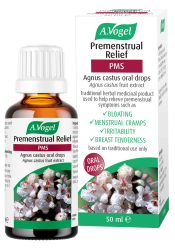An introduction to painful periods
Painful periods (dysmenorrhoea) are common; up to 80% of women experience some degree of pain in the lead up to their period. But how much pain is normal? Why do some women just feel a slight twinge that they barely notice whereas others suffer excruciating pain that often spreads from their tummy, into their back and even radiating down their legs?
On this page I discuss what actually causes painful periods, what symptoms you might experience as a result of dysmenorrhoea and most importantly, how you can effectively manage it.
Causes
Periods pains are often described as ‘cramp’. Generally, these cramps are a result of contractions of the smooth muscle layer of the womb and as a result of this the lining of your womb is shed to give you what we call your period.
A number of factors can contribute to how much pain you experience every month. Generally though, painful periods can be split into two types; primary and secondary dysmenorrhoea.
Primary dysmenorrhoea
Primary dysmenorrhoea is the most common type of painful periods. The pain is often fairly mild but up to 10% of women have pain so severe it affects their day to day lives. The cause of primary dysmenorrhoea (and the variation between different women) is not entirely understood as there are no abnormalities in the structure and function of the womb.
In primary dysmenorrhoea pain is often felt a few days prior to your period and sometimes continues throughout the first few days, however it tends to gradually lessen in severity and often tails off throughout the duration of the bleed.
Theories as to what causes primary dysmenorrhoea are as follows:
- Hormones – Fluctuating hormones are thought to have a part to play in giving rise to stomach cramps during a woman’s period. If any one of your sex hormones becomes ‘dominant’ when it shouldn’t be, this can give rise to issues. Oestrogen dominance, for example, is thought to give rise to heavier, more painful periods
- PMS – There are different classes of PMS but very often, typical PMS symptoms including feeling angry, irritable, having sore breasts and very heavy, painful periods. PMS and the associated symptoms are also often thought to be linked to a hormone imbalance
- Prostaglandins – Hormone-like chemicals called prostaglandins are thought to have a part to play in dysmenorrhoea. Prostaglandins help the womb to contract during a woman’s period but if these build up in the lining of the womb, they can make the contractions of the womb too severe which can be painful
- Other inflammatory markers – there is some evidence to suggest that inflammatory markers such as C-reactive protein (CRP) could contribute to period pain. Women with raised CRP levels were found to have between a 26 and 41% increase in PMS symptoms, including pain. However, more research is needed and it isn’t clear if this is a direct link
- The coil – There are different types of the coil, but the intrauterine device (IUD) is a non-hormonal version. The IUD is a small T-shaped plastic and copper device which is inserted into the womb as a method of contraception. Often this can give rise to heavier, longer or more painful periods at first but this should settle down after the first three to six months
- Psychological factors – it is suspected issues such as stress, anxiety or depression could result in an increased sensitivity to pain. This theory isn’t clear-cut but there is thought to be a link in many cases between psychological issues and troublesome, painful periods.
Gold, E.B., Wells, C. and Rasor, M.O (2016). Journal of Women's Health, ahead of print doi:10.1089/jwh.2015.5529.
Secondary dysmenorrhoea
Secondary dysmenorrhoea is a result of some problem or condition affecting the womb. The pain associated with secondary dysmenorrhoea often lasts longer than that of primary and it often starts in the days before the period commences and then continues throughout the menses (time of menstruation). In some cases the pain is apparent at other times of the month, even after your period has been and gone.
Common conditions associated with secondary dysmenorrhoea include:
- Endometriosis – Endometriosis is a condition of the womb and results in small sections of the womb ending up outside the uterus, for example in the fallopian tubes, ovaries or vagina. Endometriosis often gives rise to painful, heavy periods
- Fibroids – Fibroids are non-cancerous tumours that form in the womb. In some cases, fibroids don’t give rise to any symptoms; however, in other cases they are responsible for very heavy, painful periods.
- PID – Pelvic inflammatory disease (PID) is an infection of the womb and/or the fallopian tubes. This can be treated with antibiotics but can cause pain both during your period and throughout the rest of your monthly cycle
- Adenomyosis – adenomyosis is a condition where the inner lining of the uterus (endometrium) breaks through the muscular wall of the womb (myometrium). This condition can give rise to bloating and very heavy, painful periods
- Cancer – cancer of the uterus or ovaries can also give rise to painful, heavy periods. If your periods suddenly change or your symptoms become worse, it is advised you visit your doctor.
Signs and symptoms of dysmenorrhoea
The most common symptom of dysmenorrhoea is stomach pain or cramps, however it doesn’t stop there and many women have a whole host of other symptoms. Common symptoms of primary dysmenorrhoea are as follows:
- Stomach pain or cramps
- Back ache
- Looser bowels
- Bloating
- Nausea
Secondary dysmenorrhoea may include the above symptoms but often some others in addition to these:
- Irregular periods
- Heavy periods
- Spotting in between periods
- Pain outwith the time of your period
- Pain during or after sex
- Pain spreading into the back , legs and back passage
Many women suffer from extreme pain at the time of their period and if this is the case or your pain has suddenly become worse, you should pay a visit to your doctor.
In addition to these symptoms, women can experience a whole host of symptoms around the time of their periods, not just pain! Some of these are related to the pain, but often hormones are the root cause of many of these issues.
Women can experience changes in their mood, confidence, have pain elsewhere as well as nausea, cravings, insomnia... the list goes on.
If your symptoms affect your day to day life then you may have pre-menstrual syndrome (PMS). Click the link to visit A.Vogel Talks PMS and learn more about the symptoms.
What can I try at home for painful periods?
If painful periods are really getting you down, there are some useful home remedies you can try to help offer you some relief:
- Hot water bottle – Applying heat to the source of period pain can be effective
- Your sleeping position – The position in which you sleep can also help with period pain. Sleeping on your side with your knees pulled up (also known as the foetal position) can help to take the pressure off of your abdomen and can help to reduce pain
- Drink plenty of water – It is important to drink lots of water every day but especially around the time of your period. Drinking water helps to keep your bowels moving. Constipation and a fuller large intestine can push into your uterus and make your pain worse
- Exercise – gentle exercise can help to ease period pain as it increases blood flow to the affected area and can also initiate the release of feel-good hormones called endorphins. Endorphins can help with mood and pain perception
- Diet – your diet is also crucial, especially around the time of your period. Be sure to include lots of magnesium-rich foods which can help with muscle relaxation and limit caffeine and inflammatory foods such as refined sugar and processed meat or packaged foods which could potentially make the issue worse. Include lots of sources of omega-3 such as oily fish, eggs and walnuts which are anti-inflammatory.
Can any herbal remedies help?
There are some herbal remedies that could be useful to help overcome painful periods:
- Agnus castus – Agnus castus is a traditional herbal remedy used to help relieve premenstrual symptoms such as anger, irritability, fluid retention, sore breasts and painful periods. Agnus castus takes a while to work so ensure you take it every day for up to three menstrual cycles
- Stress Relief drops – stress and anxiety could be making your period pain worse. Try taking our Stress Relief Drops to help you better manage your symptoms of stress and mild anxiety.
Please note if you are taking hormonal contraceptives such as the pill, hormone-balancing herbal remedies may not be suitable for you.
Can my doctor help?
Conventional medicines are available to help you cope with dysmenorrhoea if home and herbal remedies fail to hit the mark. Over the counter painkillers such as paracetamol or ibuprofen may help, although always beware of any side effects associated with these.
The contraceptive pill may be an option too and in extreme cases, your doctor may prescribe stronger painkillers or anti-inflammatory medication.





 Looking for our products in a store near you?
Looking for our products in a store near you?

